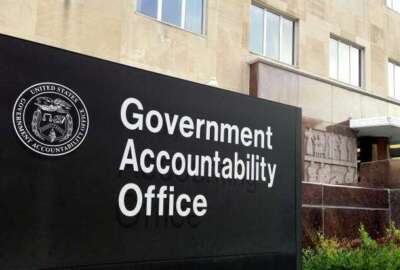
Hubbard Radio Washington DC, LLC. All rights reserved. This website is not intended for users located within the European Economic Area.
Hubbard Radio Washington DC, LLC. All rights reserved. This website is not intended for users located within the European Economic Area.
Figures from the Government Accountability Office show a 12% drop in the number of contracting protests in fiscal '22 relative to the year before, protests are ...
Best listening experience is on Chrome, Firefox or Safari. Subscribe to Federal Drive’s daily audio interviews on Apple Podcasts or PodcastOne.
Figures from the Government Accountability Office show a 12% drop in the number of contracting protests in fiscal ’22 relative to the year before. Protests are down 40% since 2018, what does it all mean? Well, our next guest says the protests that do happen still have a lot of impact. Federal sales and marketing consultant Larry Allen joined the Federal Drive with Tom Temin.
Interview transcript:
Tom Temin: And so is this good news or bad news that the protests are dropping Larry?
Larry Allen: Tom, I think there’s a little bit of good news and bad news for everybody there, there’s a little something for everyone in these reports. The good news is that the total number of protests is down and continues to shrink. That reflects, I think, a robust federal market. Usually you have a lot of protests, if companies aren’t confident that there will be a lot of new opportunities that they can bid on. That is, if the overall federal contract spending is down, people will protest more about whatever spending there is to allocate. Conversely, if the federal market is growing and is robust, companies are less likely to protest a specific opportunity with the idea that there’ll be another opportunity coming right down the pike after it. So in terms of specific pieces of business, you’ve seen protests go down. However, in terms of these larger IDIQ contracts, I would suggest that the number of solicitatio- based protests has probably actually gone up. And here we’re talking about contracts like GSA’s Polaris program, NIH’s CIO-SP4, several others, these are high stakes contracts that, particularly small businesses really want to get on. And why not, if you’re a small business, you do better as a percentage on an IDIQ contract than you do selling through the open market. So you really want to make sure you get on that contract. Unfortunately, that’s where we’re still seeing a substantial amount of protest activity, Tom. And that’s really slowing things down.
Tom Temin: And if you look at the GSA strategy for a couple of those big upcoming GWACs, one of the things they’re adding, which I don’t think we’ve seen before, is regularized on-ramps so that people that don’t make the initial roster of vendors will have a chance next year and the year after these things run for 5,6,7, 10 years. So that ability to get on later. If you don’t get on this time, could that perhaps reduce protests in the future? Do you think?
Larry Allen: Well, that’s just one reason why GSA is taking that approach, Tom, the idea that, hey, if you’re not on today, you don’t need to protest and hold up the program, you’ll get a chance to probably bid again in another 18 to 24 months. You know, the other reason they’re doing that is to make sure they keep technology and solutions fresh. But certainly reducing the risk of a protest is part of their thinking. Also, I think one of the things GSA is contemplating doing is doing away with a couple of contracts with contract level pricing. So that’s one less thing to negotiate or have to prove at the contract level, Tom. Yeah, it’s not coming to the scheduled program, I want to emphasize, but it is being discussed seriously for a couple of other GSA contract methods. So I think the idea is that GSA would like to get these contracts in place, get them in place in a timely manner. And in order to do that, you have to, you’re never gonna get a protest proof procurement. But you can try your best to put out a protest resistant one.
Tom Temin: And in the general area then, the protests are dropping, That seems to be then in the full and open regular contract awards that agencies do outside of using these big vehicles.
Larry Allen: That’s true. But even inside those numbers, Tom, there’s something neat, and that is that protesters get something that they want a little over 50% of the time. And that number has been reasonably consistent for the last several years now. What that means is you don’t automatically get a sustain of your protest. In fact, the overall sustain rate dropped again, and I think it’s down near about 12% now, but what that does mean is that you’ve got a 50 – 50 chance of an agency taking some remedial action, if you file a protest at GAO that has some sort of merit to it. So what that really gives you as the protesting contractor is the opportunity to bid again, another day for that piece of business. And if you’ve been spending months or years of capture time and capture dollars, it might make sense for you to file that type of a protest, because that’s pennies on the dollar for what you’re already invested in that particular area. And if you do have a fairly quick resolution where the agency pulls something back, they’re going to revise the procurement, give you and others another chance to bid again when you’ve already seen some of it before. So you should have a better idea of how to respond. If they don’t settle, if the agency doesn’t take remedial action, then you’re gonna have a very high bar at GAO to prove your case.
Tom Temin: We’re speaking with Larry Allen, president of Allen Federal Business Partners. And I want to ask you about something where you’re really weighing in to controversial territory. And that is urging the return of in-person meeting. As in the importance of getting away from some of this virtual stuff, in order to reach the government and convince them that this is a vendor you should consider. Tell us more about your thinking there.
Larry Allen: This article comes not just from my personal experience, but from discussions I’ve had with other people in industry, and frankly, even some people in government, I know that you and others were up recently in Hershey, Pennsylvania, for the ELC conference, that was a tremendous opportunity to meet with the technology world in a one-on-one basis, or at least an in-person basis. I’m sure there were some one-on-one meetings that took place there. But even if you’re having a smaller meeting, when it’s just your company, or maybe you and somebody in a federal agency, or another contractor that you want to team with, undeniably everybody’s recent experience, Tom shows that the in-person meeting gives you the opportunity to make a different level of connection, than if you’re on Zoom or on another virtual platform. Those platforms get stuff done, make no mistake about it, you can do a lot more virtual meetings in a day than real ones. But there’s a definite benefit. We are not virtual people, Tom, we are real people, at least most of us. So if you’re a real person, you want to go out and have another actual meeting with another real person or real group of people. Because you never know, you may end up going down a discussion line that wasn’t originally on your mind or originally on the agenda for the meeting, that could be really beneficial for you, or your contact, you could end up walking down the halls of, not the office building, but the Starbucks, if you’re meeting there and see somebody else from the agency that you really wanted to talk to. You’re never going to get that opportunity on a virtual platform. So I’m advocating that people get out that they try to set up these meetings, you may not be able to get into a federal office building. But you may be able to go next door to that federal office building. Or maybe your point of contact is working remote. And they’re only 20 minutes from where you are. Pick a place in the midpoint.
Tom Temin: And preferably not someone’s dining room.
Larry Allen: Yeah, right. Right. Yeah, I wouldn’t do that. But pick something that’s at a midpoint in a public place. And it’s just tremendous. I think if people go out and do that, I think they’ll see what I’ve seen, Tom. And that is there’s just a whole other level to being in front of a person in a business discussion.
Tom Temin: Yeah. Well, I think you’re right. But I think it’s going to take some getting over reluctance on the part of government maybe to get back into those offices. But maybe the contracting officers and program managers, well they understand that also. And a final question. The votes are being counted later on, as we speak, being cast as we speak, and should the House or the Senate or both? Or who knows what will happen? Switch party majorities, big changes in defense spending could come.
Larry Allen: I think you’re going to see changes in defense spending Tom perhaps as early as later this fiscal year, we’re going to have appropriations that looks like now decided by the next Congress, that next Congress is going to have a substantially different makeup than the current one, there’s a very good chance that today’s tallies will bring different party control for at least one chamber. And that is going to lead to a whole new group of people who have different ideas and the folks that have drawn up the appropriations so far this year. It’s also going to result in delays. But I think, you know, we should expect to see, Congress always imposes its will on defense spending to a certain amount Tom, but I think we should expect to see that even a little bit more than usual this coming winter and early spring.
Tom Temin: Larry Allen is president of Allen Federal Business Partners.
Copyright © 2024 Federal News Network. All rights reserved. This website is not intended for users located within the European Economic Area.
Tom Temin is host of the Federal Drive and has been providing insight on federal technology and management issues for more than 30 years.
Follow @tteminWFED


